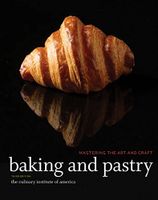Advertisement
Traditional Rolled and Cut-out Cookies
Appears in
By Culinary Institute of America
Published 2015
Dough is prepared, chilled, and rolled, then cut into desired shape before baking.
- Prepare the dough as directed. Refrigerate the dough after mixing to allow it to firm up.
- Prepare the sheet pans before beginning to roll out the dough. Pans are prepared ahead of time so that cookies may be transferred directly to the pan after cutting.
- Divide the dough into manageable portions. Work with one portion at a time and keep the remainder tightly wrapped and refrigerated.
- Lightly dust the work surface with flour. All-purpose or bread flour is most often used. Bread flour is used for dusting both because it is lower in starch and because its slightly more granular texture dusts a surface more evenly without clumping. For certain types of cookies you may use confectioners’ sugar for dusting. Some doughs are particularly soft and delicate and should instead be rolled between two sheets of parchment paper.
- Roll out the dough the desired thickness. The precise thickness depends on the formula. When rolling, occasionally rotate the dough 90 degrees to ensure that the dough is rolled to an even thickness.
- Cut the cookies with knife or cookie cutter and quickly transfer to the prepared pans so they don’t become misshapen when transferred. Rolled and cut cookies generally do not spread much, so they can be placed relatively close together on the sheet pans.
- Bake as directed. When using cutters of varying sizes and shapes, bake cookies of like sizes together to ensure even baking.
- Cool and store. Cutout cookies are often garnished with any number of glazes, frostings, nuts, fruits, and other décor.


